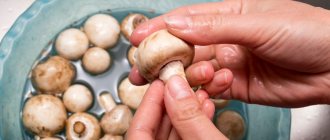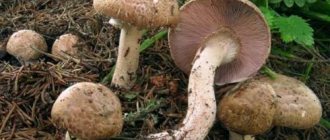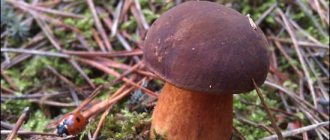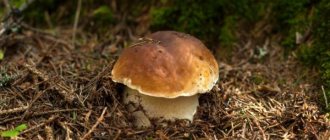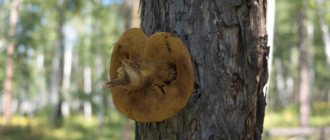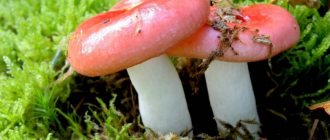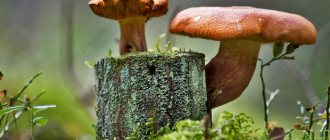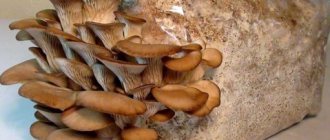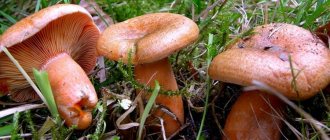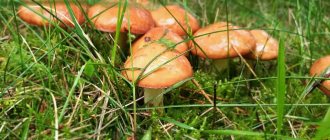How do perfectly white champignons differ from those that have blackness under the cap? Isn't she dangerous? Many people ask similar questions.
So let's talk about five signs of these mushrooms, beloved by millions, that you should always pay attention to when purchasing. Having noticed them, it is better to avoid mushrooms if you are concerned about the health of your stomach and intestines.
Smell
Any “healthy” champignon (like any other mushroom) should have a pleasant aroma - it can be mushroom or anise, which is difficult to confuse with something else. If it reeks of something very specific a kilometer away, feel free to put those mushrooms in their place and look for others.
The presence of a rotten aroma, the smell of dampness, rot, or, what is even worse, an admixture of chemical notes is a sign that the champignons have been left too long and have had time to deteriorate. There is no way you can help them - you can only throw them away, because you can’t eat them in any form.
History of growing champignons
The word “champignon” itself is translated from French as “mushroom”. They first appeared in France in the 17th century, which is why they received the French name. At the beginning of the 19th century, these mushrooms began to be cultivated in Russia.
Today, champignons are cultivated in many countries using bird droppings and specially treated horse manure. Mushrooms do not need sunlight, as they lack chlorophyll, which simplifies their growing conditions. As a rule, it is possible to obtain a bountiful harvest (100-150 kg) from one square meter. They have been actively cultivated for more than 200 years.
At the beginning of the 18th century in Paris, about two thousand rooms in former quarries were adapted for growing mushrooms
Sticky surface
Sticky caps are another sign of spoiled champignons. This symptom can appear in two cases: either when the mushrooms have been lying for too long in conditions unsuitable for storing mushrooms, or after defrosting. In both the first and second cases, the use of such mushrooms is fraught with problems with the health of the digestive tract.
Don't throw away old jeans. They will make a comfortable bag: follow the instructions
“Delighted with the script”: Boris Dergachev admitted his desire to play in “Slave”
Cheese, cottage cheese and other foods you shouldn’t start your day with: complete list
Good mushrooms have a completely dry and velvety surface of the caps, a uniform white or cream color; any gloss is a sign of spoilage, which nothing can be done about (even long heat treatment will not help).
Virulence
The inedible champignon actively absorbs toxic substances from the soil. Consumption of such mushrooms leads to a certain level of intoxication. According to the degree of danger, twin champignons of edible species are classified as moderately toxic, capable of causing stomach upset, which manifests itself in the form of diarrhea, vomiting, and fever. A large portion of mushrooms eaten can be fatal.
Poisonous champignons also contain substances that negatively affect proteins. This causes disruption of the contraction of the heart muscle.
Symptoms of poisoning
At the first symptoms of poisoning, call an ambulance
The first sign of poisoning is vomiting and stomach upset. These symptoms appear within 2-3 hours. Stomach colic appears later. Similar symptoms are caused by toadstool and poisonous meadow mushrooms.
There are several stages of champignon poisoning. Their description:
- Spasmodic pain appears in the abdomen, body temperature rises. Later, diarrhea begins.
- The person feels a slight improvement in health, but toxic substances continue to affect the liver and kidneys. Analyzes confirm this. Remission lasts 1-2 days.
- At this stage, damage to internal organs reaches its peak. Liver and kidney failure begins.
In case of poisoning with false champignons, it is necessary to call an ambulance at the first stage of poisoning. Before her arrival, it is important to remove toxins from the body.
Description of first aid:
- drink at least 1.5 liters of a weak solution of potassium permanganate and induce vomiting to rinse the stomach;
Irina Selyutina (Biologist):
Gastric lavage as a component of first aid is very important, because allows you to remove pieces of mushrooms from the stomach and prevents further absorption of toxins by the intestinal walls, which enter the gastrointestinal tract together. In this case, it is advisable to save the remains of the dish so that the laboratory of the medical institution can analyze and identify toxins in order to carry out treatment.
- take sorbents at the rate of 1 g per 1 kg of patient weight (maximum 10 tablets of activated carbon);
- a warm heating pad is placed on the stomach and legs: this helps to avoid circulatory problems;
- drink strong tea or warm water.
Colored hat
The surface of the cap of a good, healthy champignon suitable for food should have a uniform color, regardless of whether the mushroom is large or small. If there are even small specks of black or yellow on it, you should refuse to buy such champignons - you cannot eat them.
Ideally, the cap of a good champignon has a streamlined shape. It is better to dispose of mushrooms with a flat cap or not to buy them when it comes to choosing a product in the store.
Treatment for poisoning
After hospitalization, the patient undergoes detoxification:
- enema;
- gastric lavage;
- hemodialysis.
The choice of treatment method depends on how much of the dangerous product the patient ate.
Later, the patient’s water-electrolyte (salt) balance is restored or a drip is placed. The victim must also adhere to a special diet:
- Avoid eating fatty, spicy and smoked foods;
- eat only boiled food;
- Finely chop vegetables and fruits before eating.
When providing first aid, you should not induce vomiting in children under 3 years of age and pregnant women. Also, enemas are not given to older people without the help of a doctor. The victim is prohibited from taking medications that strengthen the stomach. This is especially important when poisoning with dangerous mushrooms such as toadstool.
Density
Good, fresh champignons always have a firm, elastic body. If it is soft, you definitely cannot eat such champignons - this is a sign that the mushrooms are already significantly spoiled.
Home greenhouse made from bottles. How to make a convenient place for cucumbers and tomatoes
There is intrigue: what you liked about the TV series “Crime 2”
Suitable for both the living room and the kitchen: a do-it-yourself corrugated table
However, loss of elasticity is usually not the only sign of spoilage of the mushroom. Most likely, to make sure that it is not fresh, you won’t even have to touch the caps.
Spoilage of canned product
Spoiled mushrooms must be disposed of immediately
The shelf life of canned champignons is longer than that of fresh mushrooms. But if the technology for preparing such a product is broken and pathogenic bacteria get inside the container, the product may become unusable in a short period of time.
You can tell that canned champignons have gone bad by the following signs:
- the marinade or saline solution has become cloudy;
- as a result of intensive reproduction, pathogenic bacteria emit gases that cause the lid to swell with preservation (it is pressed when pressed);
- The fermentation process begins - small air bubbles rise to the surface;
- a strong sour smell comes from an open jar;
- The mushrooms removed from the container are covered with some kind of mucus.
Each of these signs indicates that the mushrooms need to be disposed of.
It is also not recommended to eat a product whose shelf life has expired or whose temperature has been violated - above +30°C.
One of the dangerous diseases associated with eating home-canned mushrooms may be food botulism. Today, this is a serious, potentially fatal, but fortunately relatively rare disease. Its causative agent, Clostridium botulinum, is an anaerobic bacterium (bacillus), which, under conditions of low oxygen content in the environment, produces the so-called. botulinum toxins. It gets into canned foods along with poorly washed raw materials - mushrooms (or something else). The disease is accompanied by damage to the central nervous system and muscle paralysis, which leads to respiratory failure. The acute form is usually fatal.
By the way. In addition to the well-known method of penetration of the pathogen into the human body through the gastrointestinal tract, it can “bestow its visit” on us through the injured skin of the hands during the processing of mushrooms infected by it.
To protect yourself from possible exposure to the deadly disease botulism, when you do not want to deny yourself homemade preparations, you must:
- do not buy canned goods secondhand;
- throw away jars of homemade preserves if you see their lids are swollen;
- When canning mushrooms and other products, use your proven recipes.
Black
If you notice blackened mushrooms, refuse to buy them - they are no longer suitable for food. However, do not forget that black and darkened champignons are two different things, because mushrooms can darken as a result of long-term storage.
Identifying champignons that have just been sitting for a long time and have slightly changed their color is simple: break one mushroom. If its body turns out to be white inside, you can use it for food, but if it is dark inside, do not take it. However, remember that darkened mushrooms must also be subjected to high-quality heat treatment.
But what about the rabble under the hats? In fact, there’s nothing wrong with it (unless, of course, the mushroom itself is of normal quality) - it’s just a sign that the champignon has been sitting for a long time and, as they say, is ripe.
True, when evaluating spore-bearing plates, be sure to take into account the factors discussed above: if it is wet, sticky or smells bad, leave such mushrooms alone and better not take risks.
Found a violation? Report content
Storage rules
Now you can answer the question: is it possible to eat blackened champignons? Blackening is not always a sign of depravity. For example, if you freeze mushrooms, they will turn black over time. The same thing will happen if you fry champignons or boil them incorrectly. To eliminate the risk of poisoning from spoiled mushrooms, it is necessary to store mushrooms correctly. Firstly, after picking, the mushrooms need to be washed in a bowl of water and peeled. Secondly, the mushrooms need to be fried, boiled or stewed.
This must be done on the same day that the champignons were collected, or, in extreme cases, the next day. If you need to store mushrooms for a longer period, you can salt, freeze or dry them. The best recipes for preparing champignons can be found on this site, where you can also find specific storage rules. Generally speaking, champignons should be kept in the refrigerator, basement or other places where the temperature is 1-5 degrees Celsius.
Video: how to properly store champignons
For clarity, I recommend watching a video on how to properly store champignons. It’s worth noting right away that not everything here is as easy and transparent as it might seem at first glance. After all, you need to take into account a number of factors: method of preparation, temperature conditions, storage containers, additional ingredients in the composition, and so on. The author of the video below talks about all this in detail. In addition, the video explains how to properly collect champignons in the forest, as well as some secrets of selling surplus mushrooms. Turn on video, sound and absorb useful information. Enjoy watching!
Where and how does it grow
Forest champignon prefers nitrogenous soils and is easy to find in mixed and coniferous forests. It can often be found in anthills. The mushroom also grows in spruce forests from July to November. Scientists find both groups of mushrooms and single specimens.
The forest champignon grows in Europe, Asia, and North America. The mushroom can be found both in the mountains and in the lowlands. It also grows on lawns. In the Russian Federation, this mushroom can most often be seen in the temperate climate zone.
This champignon is a saprophyte and therefore grows on manure.
